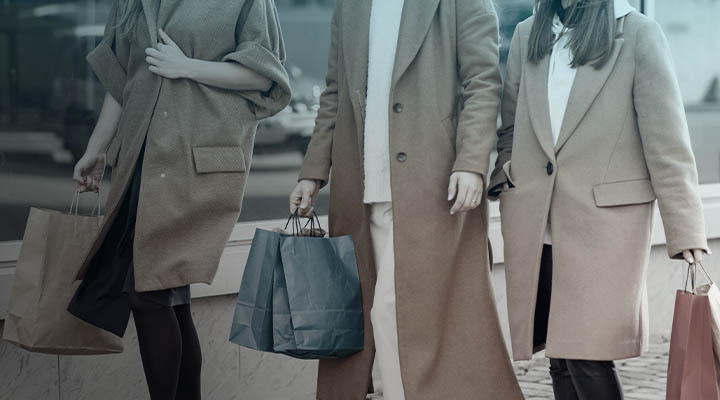BJSS is exploring how retailers are helping consumers navigate their sustainability dilemma, looking at all aspects of the value chain: sustainable design, sustainable sourcing and re-use and recycle of materials. We will provide our opinion on who’s doing it well and made a good start, our Top 10 start-ups that we think are nailing it, and what we can learn from those start-ups.
In my previous post, I outlined my thoughts on retailers’ pivotal role in creating a circular economy as they are in-between suppliers and consumers. They can demand ethically and sustainably sourced materials from suppliers, whilst simultaneously creating additional consumer demand for such products. In this post, I look at sustainability from the consumers’ perspective: their fashion education, the sustainability dilemma they face and the support they need from retailers to navigate conscious consumerism.
Consumer's Fashion Education
Clothing is a tool used to communicate about our identity and therefore it’s something we put a lot of thought into. Despite this, we often don’t know where our clothes have come from and so the impact we are having on the environment is often left unquestioned.
Unlike the plastics movement following Blue Planet II, fashion sustainability education began with influencers. Emma Watson has been a high impact sustainable fashion pioneer through being a vocal and active Good on You supporter by ‘wearing the change she wants to see’, and designing her own ethical brand collection for People Tree. Meghan Markle is also making a conscious effort to be seen out in sustainable clothing and is responsible for the 'Meghan Effect': when wearing something sustainable it sells out immediately. Her first appearance in a pair of sustainably made Outland Denim jeans saw a 2300% sales increase in the following two weeks. Although this drastic increase may seem ironic as consumers are just following a trend, this increased demand created an additional 30 jobs for women at risk, and Outland Denim received a Common Objective Leadership Award for their innovation in this space.
This importantly shows two things:
- Everyone wants to dress like Meghan
- Sustainability is becoming more mainstream, evident through the 66% search growth in sustainable fashion since 2018
This conscious consumerism education has even dripped into London Fashion Week (LFW) AW19. Retailer Mother of Pearl and BBC Earth collaborated throughout to host a series of talks discussing the effect the fashion industry has on the planet and offering tangible advice on how to act in a sustainable way, a theme throughout the week. Whilst restrictive due to only being accessible to the LFW attendees, the fact that such a big event in an industry that encourages consumers to buy what they don’t need, shows the importance of sustainability in mainstream consciousness.
What is particularly interesting about this trend is the number of synergies emerging between retailers, influencers and large corporations around the same goal: educating consumers.
The Sustainability Dilemma
The effect of this consumer education is that it creates a dilemma.
Consumers are becoming increasingly conscious of the environment and the impacts their actions have on it, yet they must reconcile this with deep-set spending habits, particularly around choice, price, convenience and value.
Millennials and Gen Z, whose spending power will soon be greater than previous generations, want to shop in a more eco-conscious way. 73% of millennials are willing to pay more for sustainable items. However, established retailers are at risk of having to play catch up to this change in behaviour as they are either:
- Not yet providing this option
- What they are providing is vastly too expensive
- They are not making their options clear
This means that these consumers either can’t yet afford it, don’t have the time to shop around, or aren’t aware of the sustainable options already out there. It’s clear that there is a demand for convenient sustainable retail, and retailers must actively begin supplying it.
The Circular Economy of Blame
Everyone in fashion blames each other for not acting. Customers say retailers don't provide them with the option, retailers say they can't keep their low prices and suppliers don't have enough demand to grow natural fibres on mass and sell them at a reasonable price.
In the middle of this are retailers who can and should be the catalyst for change. Some are doing it passively, evidenced through the $2 million spent on the ethical credentials published each week through codes of conduct, auditing and blockchain technology. Others have started actively investing in a sustainability strategy, and have found ways of doing so without impacting that all-important bottom line, take H&M as a prime example with their conscious collection. But unfortunately, most would argue that for retailers to be able to make substantial enough changes to make a difference, they need help from the ‘top’ in terms of government legislations, such as the 5p carrier bag charge. In my opinion this is retailers’ scapegoat. They don’t want to risk any investment that will disrupt their value chain and potentially impact their P&L without guaranteed returns. Sustainability is going to become the norm, just like omnichannel and seamless payments have quickly become expected. Those retailers that do not invest now will lose out on future market share.
If fast-fashion retailers take the jump to become more sustainable, they can rapidly test small changes while the interest in this topic is still growing and be ready to nail it when sustainability is no longer a nice to have, but universally expected. And best of all, they can do this by partnering with sustainability influencers, and active consumers. This will become a two-way beneficial relationship. The retailer will be helping consumers navigate their dilemma by providing more sustainable options, and in return, these consumers would be more lenient with a retailer if their trials didn’t quite go to plan, as at least they are doing something!
Published
April 29, 2024Reading time
3 minutesRelated posts





